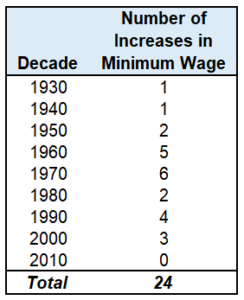There has been alot of political, economic and business conversations about the minimum wage as well as a new term, "Living Wage".
While this blog attempts to discuss local and State issues affecting the Town of Smithfield, I believed that this article would be interesting to place here.
Introduction
The first minimum wage was enacted by Congress in 1938 at 25 cents.
Historical Context
According to Wikipedia
A minimum wage is the lowest remuneration that employers can legally pay their employees—the price floor below which employees may not sell their labor. Most countries had introduced minimum wage legislation by the end of the 20th century.
The movement for minimum wages was first motivated as a way to stop the exploitation of workers in sweatshops, by employers who were thought to have unfair bargaining power over them. Over time, minimum wages came to be seen as a way to help lower-income families. Modern national laws enforcing compulsory union membership which prescribed minimum wages for their members were first passed in New Zealand and Australia in the 1890s. Although minimum wage laws are now in effect in many jurisdictions, differences of opinion exist about the benefits and drawbacks of a minimum wage.
Additional History
Minimum wages increase the cost of labor and, therefore, increase the cost of producing goods or delivery of services.
Since 1938, Congress has enacted 24 increases with the current Federal minimum wage at 7.75. A quick table of the increases by decade is shown below.

Effects of Technology on Labor
In all business for decades, companies often try to avoid minimum wage laws by using contractors (or gig) labor which then avoids the minimum wage statues at the Federal or state level). Or by integrating technology into manual functions through automation.
The increase of technology into business operations is easy to understand. Consider manufacturing, customer service and retail. The quickest and most visible technology integration is self-checkouts at retail stores.
What do businesses do in this example?
Ultimately, there are two issues: 1) customer experience and 2) cost of the labor to complete a task (checkout).
There are three costs: 1) Rennovation to the store, 2) cost of the equipment and 3) cost of labor before and after implmentation. The first one is fixed and one-time while #2 is fixed for a given period of equipment life expectency (3 -- 5 years). The third is variable for the life of the self-checkout initiative.
It's rather easy. Complete an analysis of breakeven against now (with human cashiers) and with self-checkout and deterimine the break-even.
Lastly, ensure that the customer experience does not decrease. AND, most importantly, watch the adoption rate of customers using self-checkout.
Continuation to Next Post
If you wish to read the second part to this post, click here.